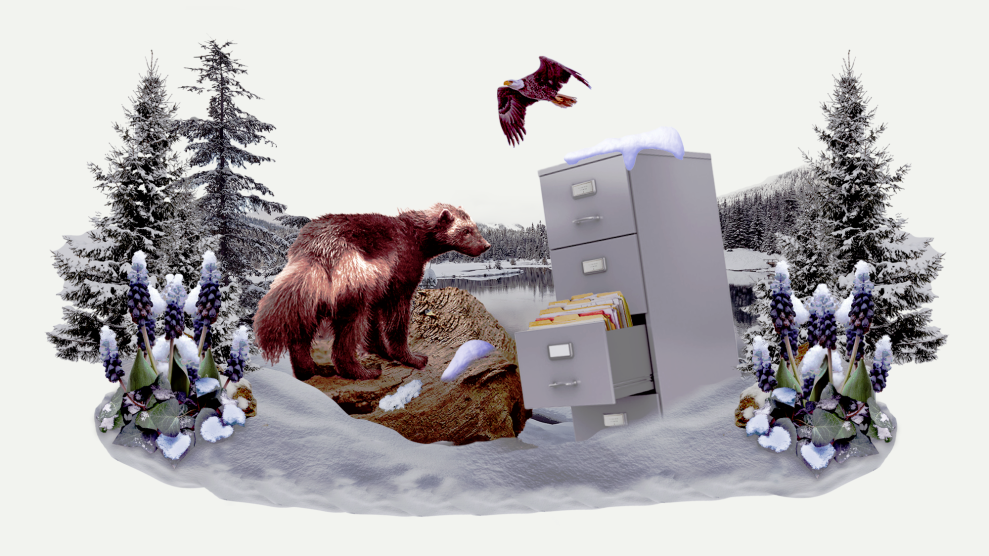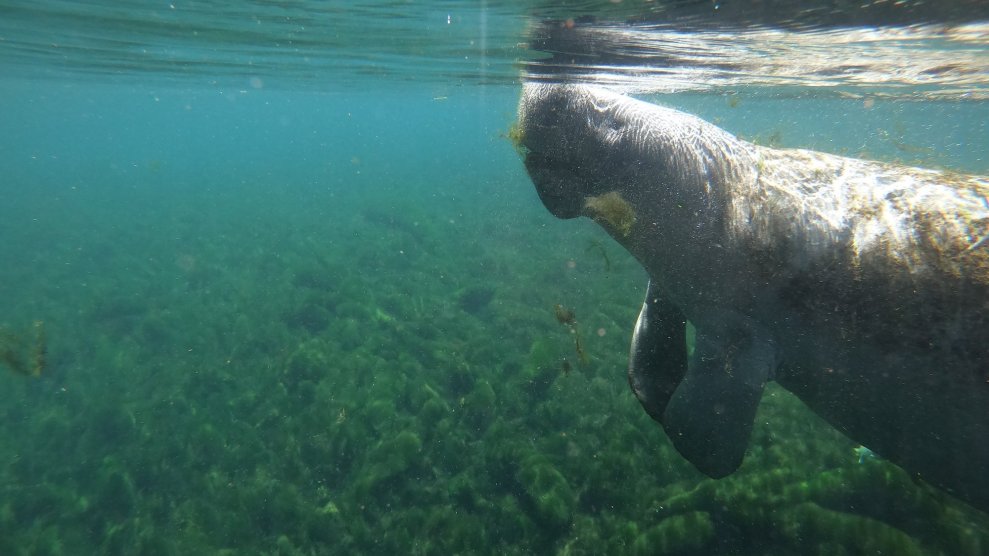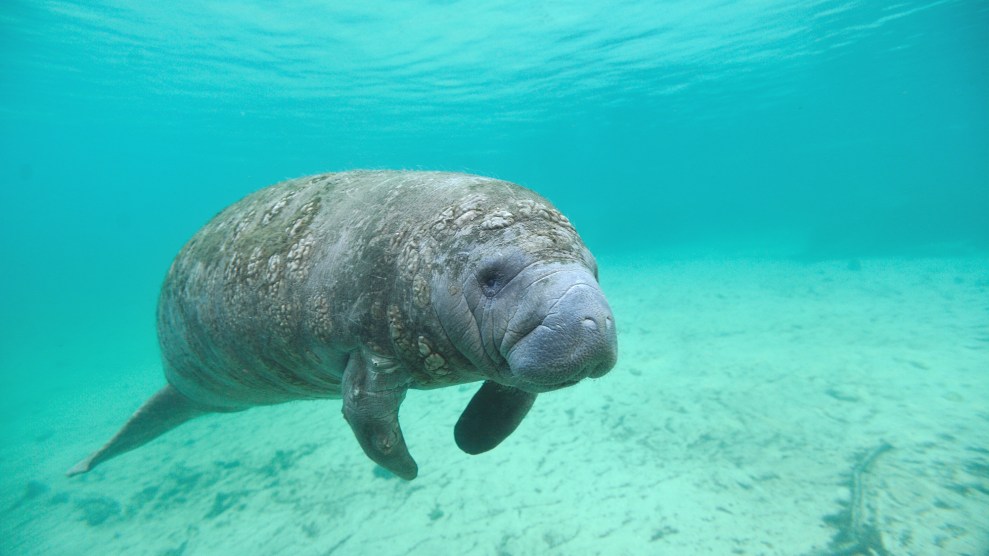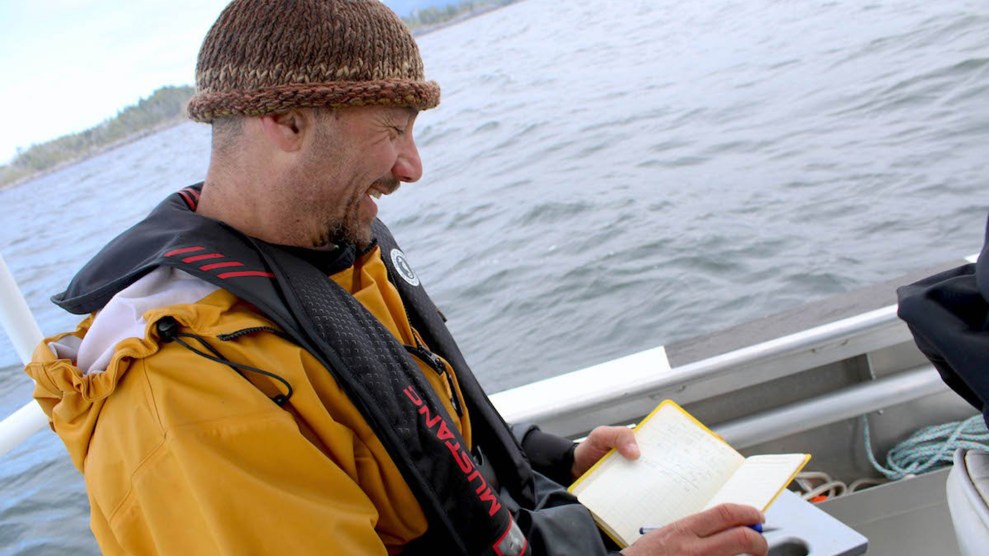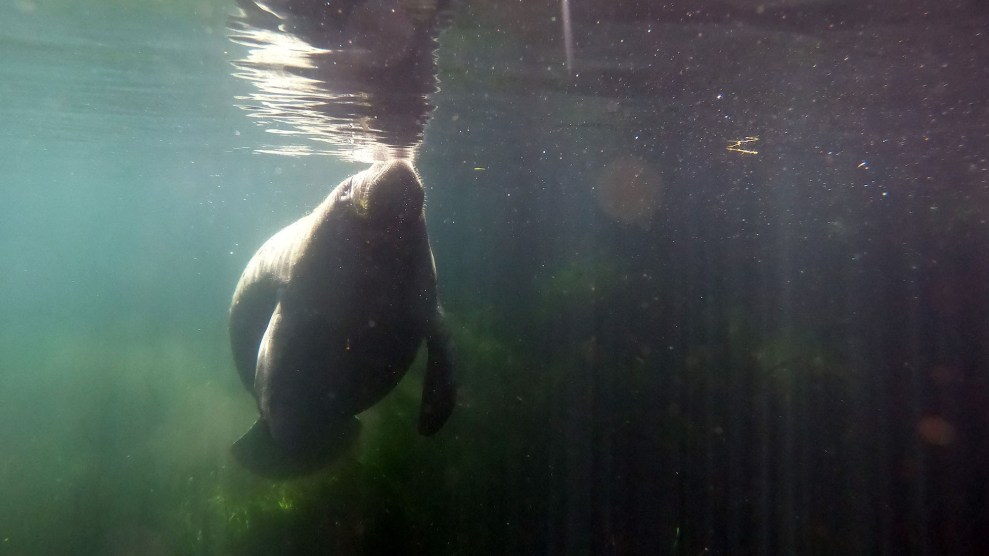
A manatee surfaces for a breath of air . Douglas R. Clifford/TNS/Zuma
This story was originally published by the Guardian and is reproduced here as part of the Climate Desk collaboration.
A picturesque expanse of water along Florida’s space coast is offering a modicum of hope for the state’s embattled manatees as wildlife officials review whether to restore the beloved sea cows to the endangered species list.
The recovery of seagrass, the manatees’ favorite food, in Mosquito Lagoon means that an emergency hand-feeding program that has kept many of the starving aquatic animals alive over the last two winters can be discontinued, at least temporarily.
While scientists say this might be only a small step in the wider fight to rescue a species that has seen a record die-off in recent years from water pollution and habitat loss, what’s happened at Mosquito Lagoon offers signposts to how the manatees’ battle for survival might ultimately be won.
“At least in a portion of the lagoon, we are seeing a rather rapid resurgence of the Halodule variety of seagrass that, even if we don’t know exactly how it happened, does tell us that it’s much more resilient than we might have been thinking,” said Dennis Hanisak, a professor of marine botany at Florida Atlantic University’s Harbor Branch Oceanographic Institute, and director of its seagrass nursery.
“If Mosquito Lagoon can make a turnaround as quickly as it did, if somehow whatever happened there could happen in the rest of the northern Indian River Lagoon, that would be really, truly good news indeed.”
Hanisak and his team, in partnership with the Florida Fish and Wildlife Commission (FWC), have focused their restoration efforts on the lagoon in northern Brevard county, one of the most popular feeding grounds for manatees during the colder winter months.
That’s where the majority of manatee deaths, an unprecedented 1,100 in Florida in 2021, 10 percent of the population, and another 800 in 2022, occurred. They were part of what federal and state authorities classify as an ongoing unusual mortality event with the majority of fatalities through malnutrition and starvation, a reflection of the loss of about 90 percent of the lagoon’s seagrass to algae blooms and pollutants.
It’s too early to say exactly what role the seagrass nursery project has had there; Hanisak says it has ramped up in size and resources in recent years as wildlife agencies respond to the disaster with improved funding.
It’s one of several projects underway in Florida (a similar initiative at Brevard zoo was launched as part of its “restore our shores” effort) in which a diverse range of seagrass varieties are cultivated for research and transplant.
It is also a prominent component of a catalog of FWC manatee habitat restoration schemes, themed mostly around improvements in water quality and aquatic vegetation, that experts believe has potential to turn years of declining numbers into a robust recovery.
“All the projects are either completed or underway. Each of them is viewed as a high priority,” Lisa Thompson, an FWC spokesperson, said.
“Manatees move long distances to find foraging resources and are generalist herbivores, but continued declines in seagrass would mean the regional populations would have to find other vegetation, freshwater marsh plants, salt marsh, overhanging vegetation, etc, on which to feed, exposing them to further stresses.”
This month, Florida’s governor Ron DeSantis announced a $100 million award of state funds for water-quality improvements in the Indian River Lagoon, one of North America’s most biologically diverse waterways. The cleaner the water, the better the seagrass.
Hanisak says his research with seagrass has been almost revelatory. He’s excited about the new level of collaboration and sharing of information that has been a silver lining of the manatee disaster.
“We learned what a delicate balance we really had for a long time between people and nutrients flowing into the system, and the microscopic algae in the water and the seagrasses,” he said.
“The algae blooms of 2011 encouraged talking more than we had been, more projects where we all work together. This whole restoration effort, we had none of that. Whoever was doing it were kind of doing their own things. Now there’s so much more communication and partnering,” Hanisak added. “The other really positive thing is the human side of it. My generation, we’ve gone through watching parts of nature fall apart, the ice caps disappearing, coral reefs declining, things we never could imagine when we were early in our careers.”
“There’s a whole generation of students now getting into the profession, and they don’t have to spend their time anymore saying: ‘Boy, is the world going bad here?’ They’re much more into: ‘What can we do? How can we turn this around?’”
All of which, in turn, is only good news for the ever-hungry manatee. Hanisak and his students have steadily been building the capacity of the seagrass nursery at multiple locations. That seagrass will ultimately be transplanted into the Indian River Lagoon and elsewhere. The students are also cultivating plants from different areas of the lagoon to preserve its genetic diversity.
It remains to be seen if this year’s drop in manatee deaths in Florida is a one-off, or represents the start of a recovery. But more abundant seagrass in Mosquito Lagoon, which led to the welcome suspension of the experimental lettuce-feeding project, bodes well.
Lawmakers also appear to be at least partly on board. Thompson said the Florida legislature provided an additional $20 million in fiscal year 2022-23 to the FWC to enhance captive manatee support facilities and manatee habitat enhancement to supplement the previous year’s $8 million.
While the money “fully supports” the projects on the FWC website, she said: “A considerable amount of funding beyond what has been provided is needed to address aquatic habitat restoration efforts in waters of the state.”
That position is supported by Patrick Rose, a veteran aquatic biologist and executive director of the Save the Manatee Club. The extra funding, which his group lobbied for, is welcome, he says, but adds that existing efforts are “a drop in the bucket literally to what needs to be done.”
Ultimately, Rose said, manatees need clear, clean water to survive. Without it, seagrass will not flourish. To that end, Save the Manatee is a party to a lawsuit against the EPA. “Nutrients are the direct cause of harmful algal blooms which have been so intense that they literally cut the light off to the seagrasses, and the seagrasses die,” he said.
“We’re going to likely see more of the problems with these massive algal blooms in other parts of Florida unless we deal with water quality, that clarity and so forth,” Rose added. “If you were to have the best seagrass nursery in the world, and you were to plant hundreds or thousands of plants but the water quality wasn’t sufficient to allow those plants to grow and thrive, then it’s a waste of time and effort.”
